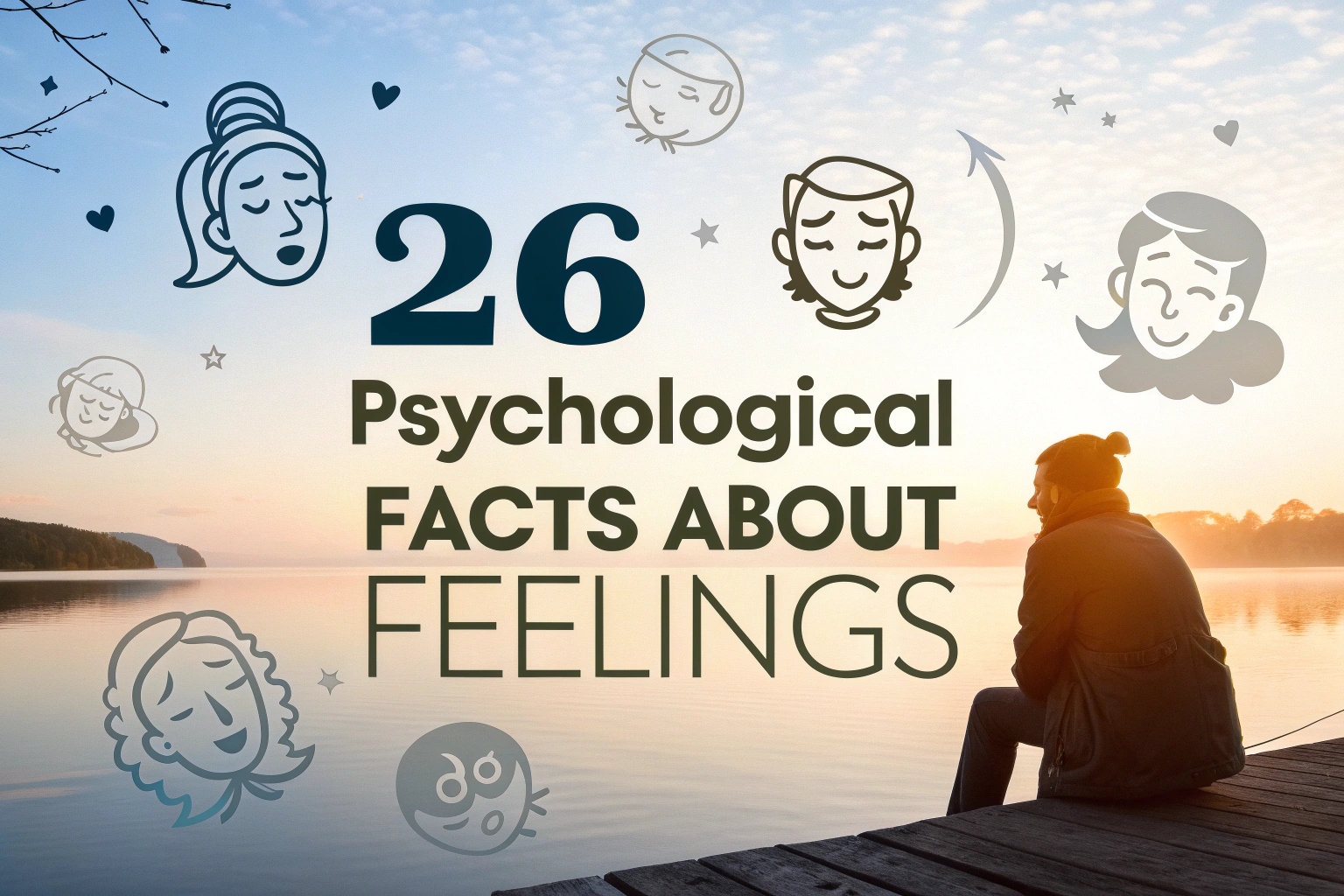Love. It’s a universal human experience, a source of immense joy, comfort, and sometimes, confusion. But what’s really going on beneath the surface?
Psychology offers fascinating insights into why we fall in love, how relationships function, and the powerful effects love has on our minds and bodies.
From brain chemistry to attachment styles, understanding the science behind love can deepen our appreciation for this complex emotion and perhaps even help us navigate our own relationships more effectively.
Dive into these psychological facts about love and discover the intricate workings of the human heart and mind.
1. Falling in Love Triggers Intense Brain Activity
When you fall in love, specific areas of your brain light up with activity. Functional MRI scans reveal increased blood flow in regions rich in dopamine, the neurotransmitter associated with reward, pleasure, and motivation.
This intense neurological response is why early love feels so euphoric, energizing, and focused. It’s a powerful biological drive that makes you crave the presence of your beloved, similar in some ways to the brain patterns seen in addiction, highlighting the compelling nature of romantic connection from the very beginning.
2. Holding Hands With Loved Ones Reduces Stress
Physical touch, especially holding hands with someone you love and trust, has a measurable soothing effect on the brain. Studies using fMRI have shown that this simple act can lower levels of the stress hormone cortisol and reduce activity in brain regions associated with threat perception and anxiety.

This comforting contact signals safety, security, and social support, effectively calming the nervous system. It demonstrates how close relationships provide a buffer against stress, contributing significantly to our emotional regulation and overall well-being.
3. We Are Attracted to People Similar To Us
While the idea of “opposites attract” persists, psychological research largely supports the “similarity-attraction effect.” We are generally more drawn to individuals who share our attitudes, values, socio-economic background, level of education, and even physical attractiveness.
This similarity provides validation for our own worldview, makes interactions smoother and more predictable, and reduces potential conflict.
Finding common ground creates an initial sense of ease and understanding, which often serves as a strong foundation for developing deeper romantic feelings and long-term compatibility.
4. Gazing Into Each Other’s Eyes Can Increase Intimacy
Sustained eye contact can be surprisingly powerful in fostering connection and intimacy. Research has shown that couples who intentionally gaze into each other’s eyes for even a few minutes report increased feelings of passionate love and affection.
This act stimulates parts of the brain associated with reward and bonding. Eye contact signals availability, attention, and presence, allowing for a deeper, non-verbal communication of emotion.
It’s a simple practice that can significantly enhance feelings of closeness and connection between partners, making them feel more seen and understood.
5. Your Attachment Style Deeply Influences Your Relationships
Developed in infancy based on interactions with primary caregivers, your attachment style (secure, anxious-preoccupied, dismissive-avoidant, or fearful-avoidant) significantly shapes how you behave in adult romantic relationships.
Secure individuals tend to feel comfortable with intimacy and independence. Anxious types crave closeness but fear abandonment, while avoidant types often value independence highly and may feel uncomfortable with too much closeness.
Understanding your own and your partner’s attachment styles can illuminate relationship dynamics, conflicts, and needs, paving the way for greater empathy and healthier interactions.
6. The “Honeymoon Phase” Has a Biological Basis
That initial period of intense passion, obsession, and euphoria in a new relationship, often called the “honeymoon phase,” isn’t just excitement—it’s biochemical.
This phase, scientifically known as limerence, is characterized by high levels of dopamine (pleasure/reward), norepinephrine (alertness/excitement), and lower levels of serotonin (which can contribute to obsessive thoughts about the partner).
This potent cocktail drives intense focus and bonding. However, these levels naturally decrease over time, typically within 12 to 18 months, as the relationship transitions towards a more stable, companionate love.
7. Love Can Literally Act as a Pain Reliever
Thinking about a loved one or simply viewing their picture can have analgesic effects. Studies have shown that activating brain regions associated with love and reward can reduce the perception of physical pain.
This effect is distinct from mere distraction; it taps into powerful reward pathways that can modulate the pain experience. Holding a partner’s hand during a painful procedure has also been shown to decrease discomfort.
This highlights the profound connection between our emotional state, social bonds, and physical sensations, demonstrating love’s tangible impact on our well-being.
8. Proximity Plays a Key Role in Attraction
The mere exposure effect suggests that simply being physically close to someone frequently increases the likelihood of developing feelings for them. Familiarity often breeds liking. We tend to develop relationships with people we encounter regularly in our daily lives – neighbors, colleagues, or classmates.
This consistent exposure provides opportunities for interaction, discovery of similarities, and the development of rapport.
While not sufficient on its own, proximity significantly increases the chances for attraction and the subsequent development of love by creating the necessary conditions for connection to spark.
9. Couples’ Heart Rates Can Synchronize
When partners feel emotionally connected, their physiological responses can actually align. Research has found that couples in close proximity, especially when interacting empathetically or engaging in shared activities, can experience synchronization of their heart rates and even breathing patterns.
This phenomenon, known as physiological synchrony, is thought to reflect a deep level of attunement and connection between individuals.
It suggests that love and empathy aren’t just psychological states but can manifest in coordinated biological rhythms, reinforcing the bond between partners on a subconscious, physical level.
10. Expressing Gratitude Strengthens Relationships
Actively noticing and expressing appreciation for your partner and their actions can significantly boost relationship satisfaction for both individuals. Gratitude fosters positive feelings, increases feelings of connection and responsiveness, and motivates partners to maintain the relationship.
When partners feel appreciated, they are more likely to reciprocate with kindness and commitment. Regularly acknowledging the good things, big or small, helps counteract the natural tendency to focus on negatives and reinforces the value each partner brings, building a more resilient and loving bond over time.
11. Sharing Vulnerability Deepens Emotional Bonds
While it can feel risky, allowing yourself to be vulnerable with a partner—sharing fears, insecurities, and deep emotions—is crucial for building true intimacy. Vulnerability signals trust and invites empathy, creating a space for deeper understanding and connection.

When a partner responds to vulnerability with acceptance and support, it strengthens the emotional bond significantly.
This mutual exchange fosters a sense of safety and closeness that superficial interactions cannot achieve, transforming attraction into a more profound, trusting love essential for long-term relationship success.
12. Love Involves More Than Just Passion
Psychologist Robert Sternberg’s Triangular Theory of Love proposes that love comprises three main components: intimacy (feelings of closeness, connectedness, and bondedness), passion (the drives that lead to romance, physical attraction, and sexual consummation), and commitment (the decision to maintain the love).
Different combinations of these components result in different types of love. While passion might dominate early relationships, lasting love (Consummate Love) ideally involves a balance of all three, evolving as the relationship matures and deepens over the shared journey of life.
13. Breaking Up Can Feel Like Kicking an Addiction
The intense cravings, withdrawal symptoms, and obsessive thoughts experienced after a breakup share neurological similarities with addiction withdrawal.
Because love activates the brain’s reward system so powerfully (involving dopamine), the abrupt absence of the loved one can lead to a state akin to withdrawal. Understanding this biological basis can help normalize the intense emotional pain of heartbreak.
It’s not just ‘in your head’; your brain is genuinely processing a significant loss, requiring time and self-compassion to recalibrate and heal from the experience.
14. Reciprocity of Liking Fuels Attraction
We are significantly more likely to develop feelings for someone if we believe they like us first. Knowing that someone finds us attractive or interesting boosts our self-esteem and makes us view that person more favorably.
This principle of reciprocity is a powerful factor in relationship initiation. It reduces the fear of rejection and creates a positive feedback loop where mutual liking can grow.
This psychological tendency highlights the importance of showing interest and appreciation when you are genuinely attracted to someone you know.
15. Shared Novel Experiences Reignite Passion
Engaging in new, exciting, and slightly challenging activities together can help couples rekindle feelings of passion and closeness. Novel experiences trigger the release of dopamine and norepinephrine, mimicking some of the brain chemistry present during the initial stages of falling in love.
Breaking routine and creating shared memories through exploration or learning something new injects energy and excitement into the relationship.
This suggests that actively seeking novelty together is a valuable strategy for maintaining relationship satisfaction and preventing boredom over the long term.
16. The Way Couples Argue Predicts Longevity
It’s not whether couples argue, but how they argue that significantly predicts relationship stability. Psychologist John Gottman identified four communication styles detrimental to relationships, dubbed “The Four Horsemen”: criticism (attacking character), contempt (disrespect, sarcasm), defensiveness (blaming, avoiding responsibility), and stonewalling (shutting down).
Couples who consistently engage in these patterns are at higher risk of separation. Conversely, couples who manage conflict constructively—using “I” statements, validating feelings, and seeking compromise—tend to have stronger, more resilient relationships built on mutual respect.
17. Long-Distance Love Can Foster Idealization
While challenging, long-distance relationships can sometimes lead partners to idealize each other more than geographically close couples might.
The limited face-to-face interaction means partners often focus on positive qualities and memories, potentially glossing over day-to-day annoyances or incompatibilities.
They may also put more effort into communication when they do connect. While this idealization can strengthen feelings temporarily, it’s important for long-distance couples to eventually navigate real-world, everyday life together to ensure compatibility beyond the idealized image created by separation.
18. Pheromones May Play a Subtle Role in Attraction
While human pheromones are debated, research suggests that subconscious olfactory cues related to our immune system (specifically the Major Histocompatibility Complex or MHC) might influence attraction.
Studies indicate we may be subtly drawn to partners with MHC genes different from our own. This genetic diversity could potentially lead to offspring with stronger immune systems.
While scent preferences are complex and influenced by many factors, this suggests a primal biological mechanism subtly guiding our choices towards genetically compatible mates, operating beneath our conscious awareness.
19. Laughter Truly Is Good Relationship Medicine
Sharing moments of genuine laughter with a partner strengthens social bonds and increases feelings of connection. Laughter releases endorphins, natural mood lifters and stress reducers, creating positive shared experiences.
Couples who laugh together often report higher relationship quality and are better equipped to handle stress and conflict.
It fosters a sense of playfulness, lightheartedness, and shared joy, reinforcing the positive aspects of the relationship. Prioritizing humor and finding opportunities to laugh together is a simple yet effective way to nurture intimacy and resilience.
20. Commitment is More Than Just Feelings
While feelings of love are important, psychological models like the Investment Model emphasize that commitment is also heavily influenced by relationship satisfaction, the level of investment (time, emotion, shared resources), and the perceived quality of alternatives.
Even if satisfaction dips, high investment and poor alternatives can keep commitment strong. This explains why people sometimes stay in relationships even when happiness fluctuates.
Commitment is an active decision to maintain the relationship through challenges, based on a complex calculation of rewards, costs, investments, and options.
21. Love Can Broaden Your Sense of Self
Falling in love and building a close relationship often leads to “self-expansion.” As you spend time with your partner, you incorporate aspects of their perspectives, interests, skills, and resources into your own sense of self.
You learn new things, try new activities, and adopt new ways of thinking, effectively broadening your identity and capabilities.
This process of growth and enrichment is one of the deeply rewarding psychological benefits of being in a loving partnership, contributing to personal development alongside relationship development and overall happiness.
22. We Often Think Partners Know What We’re Thinking
The “illusion of transparency” is the common tendency to overestimate the extent to which our internal states—our thoughts, feelings, and intentions—are obvious to others, especially our partners.
We assume our partner understands why we’re upset or what we need without us having to explicitly state it. This can lead to misunderstandings and frustration when our partner inevitably fails to read our minds.
Recognizing this bias highlights the critical importance of clear, direct communication in relationships to ensure needs and feelings are truly understood.
23. Physical Attractiveness Creates a ‘Halo Effect’
People often unconsciously assume that physically attractive individuals possess other desirable traits, such as intelligence, kindness, and success – this is known as the halo effect. While initial attraction is often strongly influenced by appearance due to this bias, its role tends to diminish as people get to know each other better.
Personality, shared values, and emotional connection become more critical for long-term relationship satisfaction and love. However, the halo effect significantly impacts first impressions and the early stages of dating and partner selection processes.
24. Doing Favors For Someone Increases Your Liking
Surprisingly, performing a favor for someone can increase your liking for them, not just the other way around. This is known as the Ben Franklin effect.
The psychological reasoning involves cognitive dissonance: our minds strive for consistency, so if we do something nice for someone, our brain rationalizes it by concluding we must like that person.
In relationships, this suggests that actively investing effort and kindness into your partner not only benefits them but also reinforces your own positive feelings and commitment towards them.
25. Companionate Love Predicts Long-Term Happiness
While passionate love is thrilling, it’s companionate love—characterized by deep affection, intimacy, trust, and commitment—that is more strongly associated with long-term relationship satisfaction and overall life happiness.
This form of love develops over time through shared experiences, mutual support, and deep understanding.
It provides a stable foundation of friendship and partnership that sustains couples through life’s challenges long after the initial intense flames of passion have mellowed. Nurturing this deep connection is key to enduring relationship success and well-being.
26. Love Motivates Significant Life Changes
Being in love can be a powerful motivator for positive self-improvement and significant life changes. People may quit bad habits, pursue new career goals, improve their health, or become more empathetic, often inspired by their partner or the desire to build a better future together.
The support and accountability found in a loving relationship can provide the strength and encouragement needed to undertake challenging personal transformations.
This highlights love’s capacity not just for connection, but also as a catalyst for personal growth and achieving one’s potential.
Learn more astonishing details:
26 Crazy Facts About Cats That Will Make You Love Them More!
10 Interesting Facts You’ve Never Heard Before!
20+ Insane Facts About Animals That Defy Belief!
15+ Interesting World Facts: Say ‘Wow’ to These Discoveries!





